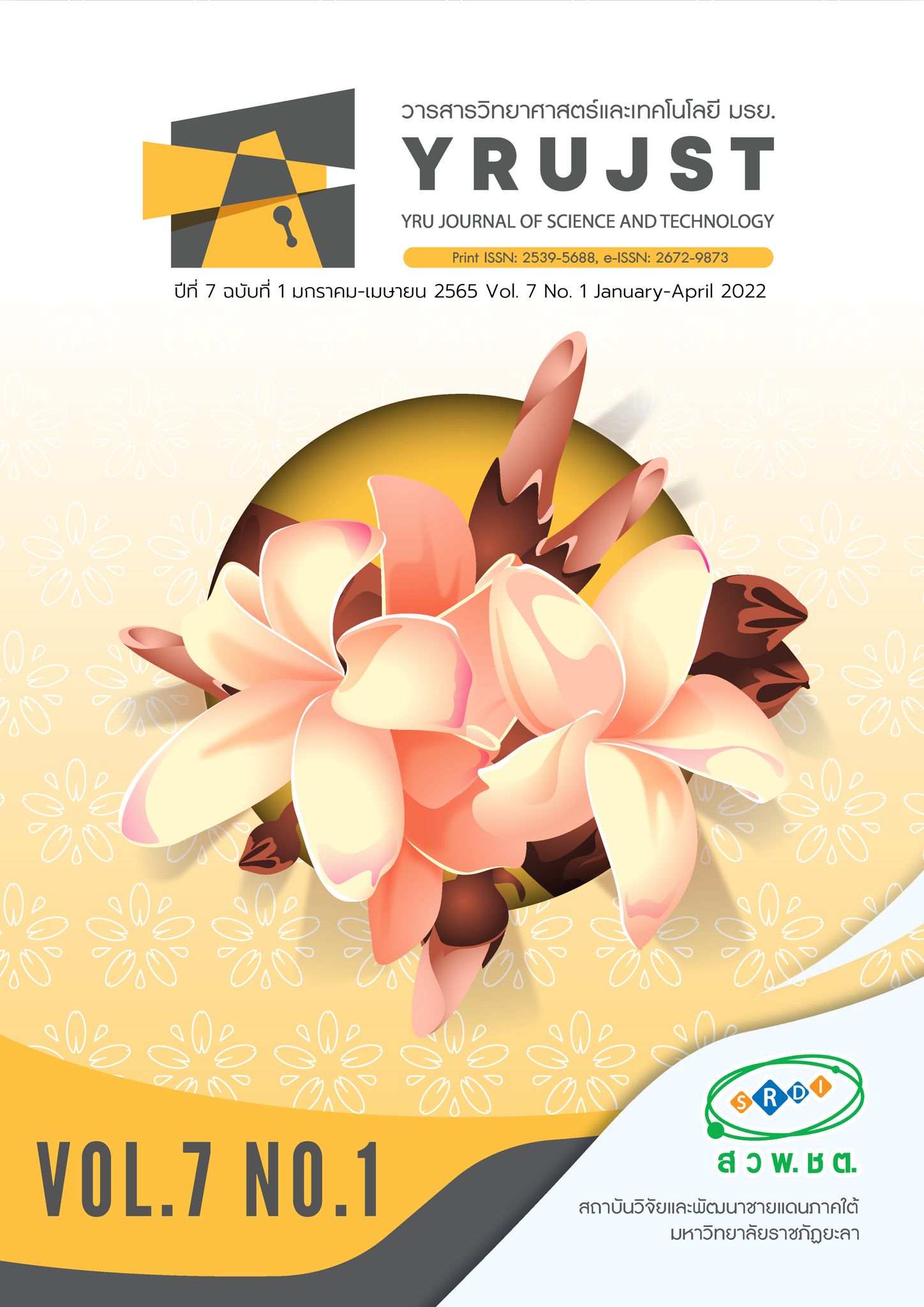สมบัติเชิงหน้าที่ของโปรตีนไฮโดรไลเซทจากจิ้งหรีดทองแดงลาย (Archeta domestica) ที่สกัดด้วยเอนไซม์อัลคาเลส
Main Article Content
บทคัดย่อ
ในสถานการณ์ปัจจุบันที่ประชากรของโลกเพิ่มขึ้น ทำให้การผลิตอาหารกลุ่มโปรตีนจากพืชหรือเนื้อสัตว์มีไม่เพียงพอ และต้นทุนในการผลิตสูง แมลงกินได้จึงเป็นทางเลือกของแหล่งอาหารกลุ่มโปรตีน จึงทำการวิจัยโดยมีวัตถุประสงค์เพื่อศึกษาการสกัดโปรตีน
ไฮโดรไลเซทและสมบัติเชิงหน้าที่ของโปรตีนไฮโดรไลเซทจากจิ้งหรีดทองแดงลาย (Archeta domestica) โดยใช้เอนไซม์อัลคาเลส ความเข้มข้นที่ต่างกัน ร้อยละ 1, 3 และ 5 ต่อปริมาณโปรตีนในตัวอย่าง เป็นเวลา 24 ชั่วโมง ผลการวิจัย พบว่าการใช้การใช้เอนไซม์อัลคาเลสที่ความเข้มข้นร้อยละ 3 เป็นเวลา 6 ชั่วโมง ให้ระดับการย่อยสลายร้อยละ 80 และได้ผลผลิตเฉลี่ยร้อยละ 21 (เทียบจากร้อยละของโปรตีนที่ละลายน้ำ) โปรตีนไฮโดรไลเซทที่ได้จากสภาวะดังกล่าว มีปริมาณกรดแอมิโนกลูตามิก และวาลีน 16.28 และ 13.07 กรัมต่อ 100 กรัมตัวอย่าง ตามลำดับ มีสมบัติการละลายร้อยละ 96.97 ที่พีเอช 12 และความสามารถในการละลาย ร้อยละ 53.75 ที่พีเอช 4 มีความสามารถในการเกิดโฟมและความคงตัวของโฟม ที่พีเอช 12 ร้อยละ 96.80 และร้อยละ 150 ตามลำดับ มีค่าดัชนีการเกิดอิมัลชันในช่วงพีเอช 2–12 อยู่ระหว่าง 13.52 – 18.13 m2/g กิจกรรมการต้านออกซิเดชัน DPPH 17.45 mg TE/g sample โมเลกุลของโปรตีนไฮโดรไลเซทมีขนาดลดลงจาก 15–250 kDa ได้เป็นขนาดเล็กกว่า 10 kDa การสกัดโปรตีน
ไฮโดรไลเซทจากจิ้งหรีดทองแดงลายด้วย เอนไซม์อัลคาเลสความเข้มข้นร้อยละ 3 เป็นเวลา 6 ชั่วโมง ได้ระดับการย่อยสลาย
และร้อยละของผลิตสูงที่สุดซึ่งสามารถนำไปประยุกต์ในผลิตภัณฑ์อาหารต่อไป
Article Details
บทความ ข้อมูล เนื้อหา รูปภาพ ฯลฯ ที่ได้รับการเผยแพร่ในวารสารวิทยาศาสตร์และเทคโนโลยี มรย. นี้ ถือเป็นลิขสิทธิ์ของวารสารวิทยาศาสตร์และเทคโนโลยี มรย. หากบุคคลหรือหน่วยงานใดต้องการนำทั้งหมดหรือส่วนหนึ่งส่วนใดไปเผยแพร่ต่อหรือกระทำการใดๆ จะต้องได้รับอนุญาตเป็นลายลักษณ์อักษรจากวารสารวิทยาศาสตร์และเทคโนโลยี มรย. ก่อนเท่านั้น
เอกสารอ้างอิง
Adebowale, Y. A., Adebowale, K. O., & Oguntokun, M. O. 2005. Evaluation of nutritive properties of the large African cricket (Gryllidae sp.). Pakistan Journal of Scientific and Industrial Research, 48(4), 274-278.
Ademola, O., A., Omolara, A., H. & Abioye, O. R. (2017). Amino acids profile of Bee brood, Soldier termite, Snout beetle larva, Silkworm larva and pupa: Nutritional Implications. Advances in Analytical Chemistry, 7(2), 31–38.
Agugliaro, F.M., Muros,M.J.S., Barroso, F.G., Sánchez, A.M., Rojo, S. and Bañón, C.P. (2012). Insects for biodiesel production. Renewable and Sustainable Energy Reviews. 16(6), 3744-3753.
Bao, J., Zhang, X., Zheng, H.H., Ren, D.F. & Lu, J. (2018). Mixed Fermentation of Spirulina platensis with Lactobacillus plantarum and Bacillus subtilis by Random-centroid Optimization. Food Chemistry, 264, 64-72.
Benjakul, S. & Morrissey, M. (1997). Protein hydrolysates from Pacific whiting solid wastes. Journal of Agricultural and Food Chemistry, 45, 3423–3430.
Benzie, I.F.F. & Strain, J.J. (1996). The ferric reducing ability of plasma (FRAP) as a measure of “antioxidant power”: the FRAP assay. Analytical Biochemistry, 239, 70–76.
Binsan, W., Benjakul, S., Visessanguan, W., Roytrakul, S., Faithong, N., Tanaka, M. & Kishimura, H. (2008). Composition, Antioxidative and Oxidative Stability of Mungoong, A Shrimp Extract Paste, From the Cephalothorax of White Shrimp. Journal of Food Lipids, 15, 97-118.
Chobert, J. M., Bertrand–Harb. C. & Nicolas, M. G. (1988). Solubility and emulsifying properties of caseins and whey protein modified enzymatically by trypsin. Journal of Agricultural and Food Chemistry, 36, 674–677.
Eldridge A.D., Wolf W.J. and Hall P.K. (1963). Stable foams from unhydrolyzed soybean protein. Food Technology. 17: 1592-1595.
Ha, N., Jesus, G., Gonçalves, A., Oliveira, N., Sugai, J., Pessatti, N., Mouriño, J. & Fabregat, T. (2019). Sardine (Sardinella spp.) protein hydrolysate as growth promoter in South American catfish (Rhamdia quelen) feeding: Productive performance, digestive enzymes activity, morphometry and intestinal microbiology. Aquaculture, 500, 99-106.
Hall, F. (2017). Functional properties of whole tropical banded cricket (Gryllodes sigillatus) protein hydrolysates. A thesis submitted to the Faculty of Purdue University in Partial Fulfillment of the Requirements for the degree of Master of Science. Department of Food Science, West Lafayette, Indiana, USA.
Hall, F., Johnson, P.E. & Liceaga, A. (2018). Effect of enzymatic hydrolysis on bioactive properties and allergenicity of cricket (Gryllodes sigillatus) protein, Food Chemistry, 262: 39–47.
Jino, T., Siriwoharn, T., Laokuldilok, T. & Surawang, S. (2020). The Optimum Condition of Protein Hydrolysate Extractionfrom Mealworm (Tenebrio molitor). In The international conference on Food and applied bioscience 2020. 6th–7th February 2020. Chiang Mai, Chiang Mai University.
Ketnawa, S., Benjakul, S., Alvarez, O. & Rawdkuen, S. (2018). Fish Skin Gelatin Hydrolysates Produced by Visceral Peptidase and Bovine Trypsin: Bioactivity and Stability. Food Chemistry, 215, 383-390.
Klompong, V., Benjakul, S., Kantachote, D., Hayes, K.D. & Shahidi, F. (2008). Comparative study on antioxidative activity of yellow stripe trevally protein hydrolysate produced from Alcalase and Flavourzyme. International Journal of Food Science and Technology, 43, 1019–1026.
Laemmli, U.K. (1970). Cleavage of structural proteins during the assembly of the head of bacteriophage T4. Nature 227:680–685.
Moreno, P., Guadix, A., Guadix, E. & Jacobsen, C. (2016). Physical and Oxidative Stability of Fish Oil-in-water Emulsions Stabilized with Fish Protein Hydrolysates. Food Chemistry, 203, 124-135.
Munialo, C.D., Van der Linden, E., Akt, K. and de Jongh, H.H.J. (2015). Quantitative analysis of the network structure that underlines the transitioning in mechanical responses of pea protein gels. Food Hydrocolloids. 49: 104−117.
Pearce, K.N. & Kinsella, J.E. (1978). Emulsifying properties of proteins: Evaluation of a turbidimetric technique. Journal of Agriculture and Food Chemistry, 26(3), 716–723.
Purschke, B., Meinlschmidt, P., Horn, C., Rieder, O. & Jager, H. (2017). Improvement of techno–functional properties of edible insect protein from migratory locust by enzymatic hydrolysis. European Food Research and Technology, 244, 999–1013.
Razali, A.N., Sarbon, N.M. and Amin, A.M. (2015). Antioxidant activity and functional properties of fractionated cobia skin gelatin hydrolysate at different molecular weight. International Food Research Journal. 22(2): 651–660.
Sillero, J., Gharsallaoui, A. & Prentice, C. (2018). Peptides from Fish By-product Protein Hydrolysates and Its Functional Properties: an Overview. Marine Biotechnology, 20, 118-130.
Wegier, A., Alavez, V., López, J.P., Calzada, L. and Cerritos, R. (2017). Beef or grasshopper hamburgers: The ecological implications of choosing one over the other. Basic and Applied Ecology. 26: 89-100.
Yi, L., Lakemond, C.M.M., Sagis, L.M.C., Eisner–Schadler, V., van Huis, A. & van Boekel, M.J.A.S. (2013). Extraction and Characterization of Protein Fractions from Five Insect Species. Food Chemistry, 141, 3341–3348.
Yu, L., Yang, W., Sun, J., Zhang, C., Bi, J. & Yang, Q. (2015). Preparation, Characterisation and Physicochemical Properties of the Phosphate Modified Peanut Protein Obtained from Arachin Conarachin L. Food Chemistry, 170, 169-179.
Zhao, X., Vázquez–Gutiérrez, J.L., Johansson, D.P., Landberg, R. & Langton, M. (2016). Yellow Mealworm Protein for Food Purposes – Extraction and Functional Properties. PLoS ONE Journal, 11(2), e0147791.


